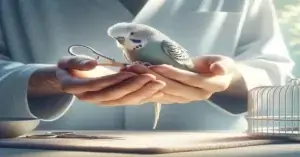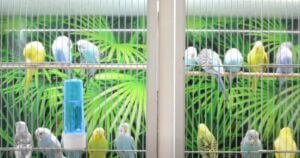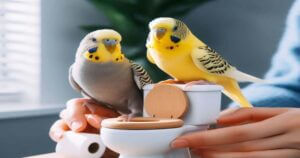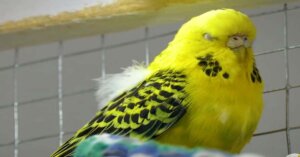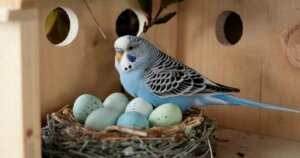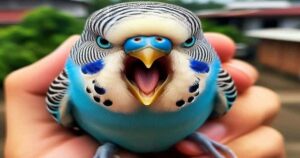Is My Budgie Molting Or Sick? Real Answer
Is your budgie molting or sick? Abnormal molting, such as missing or loose feathers, could indicate illness.
Contact a veterinarian to ensure your bird’s health. Budgies, also known as parakeets, are popular pets known for their vibrant colors and playful nature. However, as with any pet, budgies can occasionally become sick or experience natural processes such as molting.
Molting is the process by which birds shed old feathers and grow new ones. During this period, it’s common for budgies to appear dull or scruffy and become less active. However, discerning between molting and illness is crucial for ensuring your bird’s well-being.
So, let’s get started in detail.
Is My Budgie Molting Or Sick?
Distinguishing between molting and sickness in a budgie involves observing specific behavioral and physical cues.
During molting, budgies naturally shed old feathers and grow new ones, which can cause temporary changes in appearance and behavior.
Molting signs include feather loss, pin feathers (new feather growth), and increased grooming.
However, if you’re concerned about sickness, watch for persistent signs like lethargy, decreased activity, changes in eating habits, labored breathing, or abnormalities in droppings.
Unexplained weight loss, discolored or runny nostrils, or any signs of distress cause concern.
If you notice a combination of worrisome symptoms, it’s advisable to consult with an avian veterinarian promptly.
A professional assessment can determine whether your budgie is undergoing a normal molting process or if there’s an underlying health issue that needs attention.
Regular veterinary check-ups can also contribute to early detection and preventive care for your budgie’s well-being.
What Is The Difference Between Sick Birds And Molting?

During molting, birds shed old feathers and grow new ones, which may make them appear sick due to the stress it puts on their bodies.
However, sick birds may show abnormal feather growth, missing feathers, or loose feathers, indicating illness.
So, it’s essential to monitor your budgie closely for any signs of illness during molting.
When it comes to your budgie’s health, understanding the difference between molting and sickness is crucial.
Let’s delve into the key differences to help you better assess your feathered friend’s condition.
Molting Birds
- Natural Process: Molting is a natural shedding and regrowth process for birds.
- Physical Signs: During molting, your budgie may exhibit feather loss, new pin feathers emerging, and a slightly unkempt appearance.
- Behavioral Patterns: Typically, molting birds remain active, maintain their appetite, and engage in regular activities.
Sick Birds
- Unusual Behavior: Sick birds may display lethargy, decreased appetite, and a general lack of interest in their surroundings.
- Physical Symptoms: Watch for abnormal feather loss, disheveled feathers, or noticeable discomfort in your bird.
- Seek Prompt Veterinary Care: If you notice any signs of illness, consult a veterinarian to ensure your bird’s well-being.
By recognizing these distinctions, you can proactively care for your budgie and provide them with the support they need based on their specific condition.
Identifying Signs Of Illness In Budgies
Budgie owners must be vigilant in identifying signs of illness in their feathered friends. Recognizing symptoms early can help prevent potential health problems and provide timely care for the bird.
Here are some key indicators that may suggest illness in budgies:
- Abnormal feather loss or discoloration
- Unusual growths or lumps on the body
- Discharge from the eyes, nostrils, or beak
- Lethargy or decreased activity levels
- Loss of appetite or significant changes in eating habits
- Increased or decreased vocalization
- Wheezing, difficulty breathing, or open-mouthed breathing
- Nasal discharge or excessive sneezing
- Tail bobbing, indicating breathing difficulties
- Diarrhea or changes in stool color
- Vomiting or regurgitation
- Straining or discomfort while passing feces
- Visible signs of unsteadiness or difficulty perching
- Seizure-like behavior
- Head tilting or circling motions
Budgie owners should carefully monitor their pet birds for any of these signs. If any of these symptoms are noticed, seeking prompt veterinary assistance is crucial to ensure the bird’s well-being.
Regular observation and knowledge of these potential signs can help in the early detection of illness in budgies.
What Does A Molting Budgie Look Like
During molting, a budgie undergoes a natural process of shedding and regrowing feathers. The appearance of a molting budgie can vary, but some common characteristics include:
- Feather Loss: Molting budgies will experience feather loss, primarily around the head, neck, and body. This can make them look somewhat disheveled as new feathers begin to emerge.
- Pin Feathers: New feathers, known as pin feathers, will emerge from the follicles. These are covered in a protective sheath and may appear as small, pointy structures. The sheaths will break open as the feathers grow, revealing the mature feathers underneath.
- Changes in Color: The new feathers may have a different color or shade than the old ones. This is especially noticeable in budgies with more vibrant or distinct coloration.
- Scruffy Appearance: The overall appearance of a molting budgie might be scruffier than usual due to the mix of old and new feathers.
- Increased Grooming: Molting budgies may engage in increased grooming to manage the discomfort associated with the process. This can include preening and scratching.
How To Help A Molting Budgie?

Budgies are delightful birds to have as pets, but they might need some extra care and attention during molting season. It’s essential to provide them with the support they need to go through this natural process with ease, helping to ensure their health and well-being.
Here are some ways to help a molting budgie:
1. Provide a Balanced Diet
Maintaining a nutritious diet is crucial during molting. Ensure your budgie has access to a well-balanced diet comprising of seeds, pellets, fresh vegetables, and fruits. This will provide essential nutrients to support healthy feather growth.
2. Regular Bathing Opportunities
Budgies often benefit from regular bathing during molting. Offer them a shallow dish of water or a spray mist to help keep their feathers clean and alleviate itching from new feather growth.
3. Gentle Handling
During molting, a budgie’s skin may become sensitive, so gentle handling is essential. Avoid excessive petting or rubbing over the areas where new feathers are growing to prevent discomfort.
4. Reduced Stress Levels
It’s crucial to minimize any potential stress factors during molting. Keep noise levels low, maintain a consistent routine, and provide a calm environment to support your budgie throughout the molting phase.
Remember, molting is a natural process for budgies, and with a little extra care and attention, you can help them transition through this phase comfortably.
What To Feed A Molting Budgie?
During molting, providing a balanced diet for your budgie is essential. Offer a mix of high-quality pellets, fresh vegetables, fruits, and occasional protein-rich treats like boiled eggs.
However, this supports feather regrowth and aids in maintaining optimal health during this natural phase.
Here’s what you should feed your molting budgie:
1. High-Quality Seeds and Pellets
Ensure that your budgie’s diet consists of high-quality seeds and pellets to provide essential nutrients, including protein, vitamins, and minerals necessary for feather regrowth.
2. Fresh Fruits and Vegetables
Introduce a variety of fresh fruits and vegetables such as apples, carrots, spinach, and bell peppers to offer additional vitamins and minerals. These can also help in boosting their immune system during the molting process.
3. Protein-Rich Foods
Incorporate protein-rich foods like cooked eggs, cottage cheese, or small portions of lean, cooked meats to aid in feather regeneration.
4. Cuttlebone and Mineral Blocks
Provide cuttlebone and mineral blocks to supplement their calcium and mineral needs, promoting healthy feather development and overall well-being.
5. Hydration
Ensure your budgie has access to clean, fresh water at all times to support proper hydration, which is crucial for feather growth and overall health.
By offering a well-rounded, nutritious diet during molting, you can help your budgie maintain optimal health and support the regrowth of healthy feathers.
How Can I Best Prevent Illness In My Bird During Molting?
Budgies, also known as parakeets, go through molting periods where they shed and regrow feathers. During this time, taking precautions to prevent illness and keep your bird healthy is essential.
Here are some tips to help you prevent illness in your bird during molting:
- Balanced Diet: Providing a balanced diet rich in essential nutrients such as vitamins, minerals, and protein is crucial to supporting your budgie’s overall health during molting. Ensure they can access fresh fruits, vegetables, and a high-quality bird feed.
- Maintain Cleanliness: Regularly clean and sanitize your bird’s cage and accessories to prevent the accumulation of bacteria and parasites that could compromise their health during molting.
- Regular Veterinary Check-ups: Schedule routine check-ups with an avian veterinarian to monitor your bird’s health and address any issues that may arise during the molting process.
- Minimize Stress: Reduce stress factors in your budgie’s environment as much as possible by providing a quiet and comfortable living space. Avoid sudden noises or disruptions that could cause unnecessary stress during molting.
- Proper Hydration: Ensure your budgie has access to fresh, clean water at all times to prevent dehydration, which can occur more frequently during molting.
- Avoid Chemical Exposure: Protect your bird from toxic fumes and chemicals that could harm their delicate respiratory system during molting.
These preventive measures can help you support your budgie’s health and well-being during their molting process.
Taking proactive steps can minimize the risk of illness and ensure your feathered friend stays healthy and happy throughout this natural phase.
When To Seek Veterinary Care
Knowing when to seek veterinary care for your budgie is crucial for maintaining its health and well-being.
If you observe significant changes in behavior, such as lethargy, decreased appetite, or changes in vocalization, it’s a red flag that requires immediate attention.
Unexplained weight loss, difficulty breathing, or any abnormalities in the appearance of droppings should also prompt a visit to the vet. Pay attention to changes in the feathers, skin, or eyes and any signs of injury.
A budgie at the bottom of the cage shows balance issues or exhibits persistent fluffing may be unwell.
Trust your instincts; if something feels off, seeking professional avian veterinary care promptly can help address potential health issues and ensure a longer, happier life for your feathered companion.
Regular check-ups are also advisable for preventive care and early detection of any underlying health concerns.
Frequently Asked Questions On Budgie Molting Or Sick
What Does A Budgie Molting Behavior Like?
Budgie molting behavior includes quiet periods, extra sleep, and heightened jumpiness. Watch for abnormal feather growth and loose or missing feathers that could indicate illness. A molting bird’s immune system may be stressed, making it more prone to health issues.
Do Birds Get Sick When Molting?
During molting, birds may be more prone to health issues due to the stress on their immune systems. If your bird’s feathers grow back abnormally after molting, contact a vet to ensure it isn’t sick. Stress from building new feathers can be taxing on a bird’s bodily resources.
Is My Budgie Sick Or Stressed?
Your Budgie may be sick if it has abnormal feathers, loose feathers after molting, or missing feathers. It can also be stressed if it acts differently, such as vocalizing less or screaming. Contact a vet if you notice these signs.
Wrap Up
Understanding the difference between molting and illness is crucial for ensuring your budgie’s well-being. Keep an eye on abnormal feather growth and consult a vet if needed. With proper care and attention, you can help your budgie stay healthy during the molting process.
Hello Dear, I'm Poli Kolymnia, owner of many birds (including budgies).
With a deep passion for these feathered companions, I'm here to share my expertise and extensive knowledge on birds care.
My articles cover essential topics like diet, housing, care, and health, providing practical tips to help you create a happy and thriving environment for your birds.


